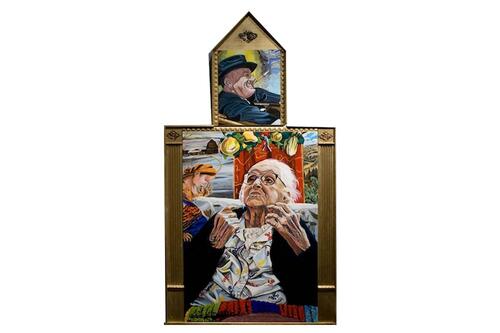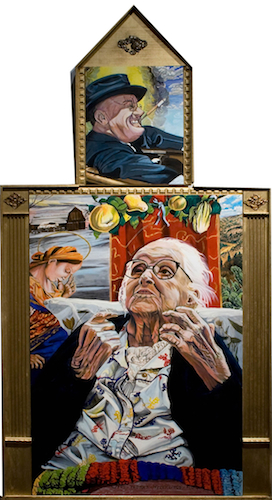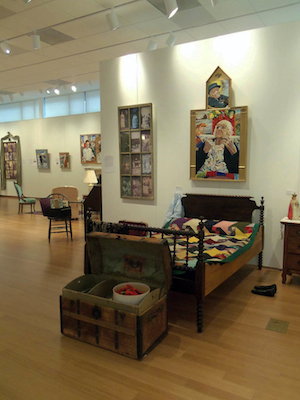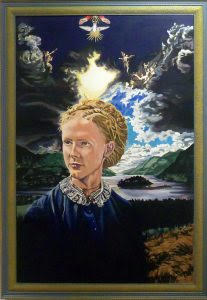
 “One day I asked my grandmother if she ever wanted to go visit Sicily. She replied, ‘Why would I want to do that? If it was so great, why did we leave?’”
“One day I asked my grandmother if she ever wanted to go visit Sicily. She replied, ‘Why would I want to do that? If it was so great, why did we leave?’”
Why, indeed — and with that question, Grandma Calogera (Carrie) Barone unknowingly planted a creative seed in the mind of her then-13-year-old grandson, Thomas MacPherson, professor in studio art.
Little did she know that it would germinate decades later in the form of egg tempera paintings — complemented by stories, photographs and local history that capture her family’s assimilation to America in his new book, Crossing Cultures: A Sicilian and American Family in Western New York (Milne Library, 2016).
Or that a portrait of her — aptly titled “La Mia Vita” (my life) — would become her grandson’s favorite in a collection of more than 40 paintings. Or that relatives like Great-Uncle Peter Barone, Great-Uncle Cosmo “Moxie” Barone and Aunt Frances (Franny) Ann O’Geen Gugino would be immortalized in both pigment and ink.
Sadly, Grandma Carrie died in 1992, just shy of 99 and 14 years before MacPherson would complete his first painting. Yet, since then, he has kept her and the Barone family memories alive in his creative pursuits.
MacPherson joined the Geneseo faculty in 1985, sharing his talent and passion in both his painting and his teaching. He was recognized with the Chancellor’s Award for Excellence in Teaching in 1999 and the Drs. Carol and Michael Harter Endowment for Faculty Mentoring Award in 2003. He teaches watercolor and drawing, and introduced a new hybrid course this semester: the history of the body and its representation (figure drawing).
True to his craft, and encouraged by his colleague, Professor of Art History Lynette Bosch, he pursued a visual arts project in 2005 to learn egg tempera painting, one of the mediums Italian artists used in the Renaissance.
“Egg tempera is an ancient painting technique where you mix powdered pigment with egg yolks and water,” he explained. “The egg yolks act as a binder that sticks to the panel, and once exposed to sunlight, it becomes as hard as glass.”
After participating in a two-week workshop in New York City, including visits to the Metropolitan Museum of Art to study priceless egg tempera paintings, MacPherson was intrigued and thought he could master the technique. When Bosch asked, “What are you going to do with it?” thoughts of Grandma Carrie flooded his mind.
MacPherson and his family had moved into her LeRoy, N.Y., house when he was 11 years old as a result of dire financial circumstances.
 “In true Italian fashion, Grandma came to our rescue by remodeling her large house so that we would each have a large apartment and semi-privacy,” he wrote in his book. “I had a front-row view of life in an Italian immigrant household.”
“In true Italian fashion, Grandma came to our rescue by remodeling her large house so that we would each have a large apartment and semi-privacy,” he wrote in his book. “I had a front-row view of life in an Italian immigrant household.”
Growing up, MacPherson savored Grandma Carrie’s authentic cooking as much as the stories she shared (“half the time in Sicilian”) and family holiday gatherings.
“The first generation of my family to live or be born in America turned out to be a collection of well-to-do businessmen and professionals with a few shady characters and, of course, homemakers,” he noted.
The Sicilian heritage and traditions were vastly different from his Scottish father’s side of the family, and MacPherson soaked it all in. The experience left an indelible impression in his heart and in his mind.
In 2006, he tapped into those rich memories while painting the first portrait of Grandma Carrie, adding elements from the past — “art history references from 400 years from Renaissance painting to make it look Italian” — and the present. More paintings followed, with Grandma being a catalyst: His collection features a half-dozen portraits of her, plus other relatives from both his mother’s and father’s side of the family.
MacPherson continued his egg tempera painting in his home studio until 2015. Depending on the size, one portrait can take from 3-to-4 weeks or 2-to-3 months to complete. In fact, the process of preparing the materials is a science all to itself with many steps.
After selecting his painting surface (usually birch plywood, fruit wood or medium-density fiberboard), MacPherson prepares it by making — and applying — four coats of rabbit skin glue. This is followed by making, applying — and then sanding — 7-to-9 coats of gesso, a combination of rabbit skin glue and terra alba (finely pulverized gypsum). After a week, he completes the preparation by going over the surface one last time with a pumice stone and water to compress the layers together. After three more days and another round of sanding, a glass-like surface awaits the artist’s touch.
But not before he cracks a few eggs. MacPherson’s egg medium recipe includes organic egg yolks, distilled water and his own secret ingredient: extra pale lager beer, which acts as a preservative and allows colors to retain their intensity.
From there, he adds pigment and with brush in hand, the rest is (art) history.
“As I started exhibiting my work, I put short bios next to my paintings,” he said. “People started looking at them and saying, ‘These are really interesting; you should write a book.”
MacPherson ended up writing a chapter a week, adding context to where the people in his portraits came from and the historical/societal connections of that time.
Take Grandma Carrie, for example. She came to Ellis Island from Valledolmo, Sicily, in 1896 when she was 3 years old. Never learned to read or write. Went to work in the fields at the age of 8. Never sick a day in her life.
“Even though he wasn’t Catholic, she thought FDR was a saint,” MacPherson recalled. So he painted the president above her head.
Then there’s “The Conversion of Great-Aunt Catherine” on his father’s side. Barely “five feet tall, with a slight build,” she had no problem breaking stereotypes. Born in 1872, she attended Ingham University in LeRoy, the first women's college in New York.
She joined Queen Alexandra’s Royal Nursing Corps, serving with the British Expeditionary Forces in Belgium in World War I, and later, the Red Cross Nursing Corps. So impressed with the Catholic priests and nuns who cared for the wounded, she converted to Catholicism, bucking the Protestant traditions of the MacPherson clan.
 As the paintings and stories evolved, so, too, did MacPherson’s solo exhibitions, which expanded into installations. He showcased his portraits in a recreated living room, dining room, bedroom, kitchen (and two MacPherson-only rooms) to better depict life in Grandma Carrie’s house. Drawers opened to show thimbles, as she was an expert seamstress. Fresh-baked cookies brought back the aroma of homemade sweets. And Geneseo’s own ethnomusicologist, Lecturer of Music Jim Kimball, once even played an accordion on display.
As the paintings and stories evolved, so, too, did MacPherson’s solo exhibitions, which expanded into installations. He showcased his portraits in a recreated living room, dining room, bedroom, kitchen (and two MacPherson-only rooms) to better depict life in Grandma Carrie’s house. Drawers opened to show thimbles, as she was an expert seamstress. Fresh-baked cookies brought back the aroma of homemade sweets. And Geneseo’s own ethnomusicologist, Lecturer of Music Jim Kimball, once even played an accordion on display.
“It’s like moving a house (the way the installation is set up),” he said. “It’s incredible how much stuff is there.”
MacPherson’s solo exhibitions and installations have been displayed at Case Western Reserve University in Cleveland; the John D. Calandra Italian American Institute at Queens College in New York City; Syracuse University; Genesee Community College; the Joy Gallery in Rochester; SUNY Geneseo; Rochester Institute of Technology; Nazareth College; and his alma mater, SUNY Oswego, among other places.
MacPherson’s painting and writing has been his attempt to pass down a wonderful part of his life.
“I was able to do an intensive research project that deals with all of the humanities and the liberal arts and it didn’t seem like work,” he reflected. “It was a real labor of love — such a creative, enlightening experience which is basically what Geneseo is all about. With the installations, I passed this approach on to my students: You just don’t’ do a painting, you do the research behind it and look into the wider picture of how a painting connected to society and affected people.”
Currently, he’s working on some additional family portraits — and toying with the idea of another installation.
-By Tony Hoppa
(Crossing Cultures: A Sicilian and American Family in Western New York is available at Amazon.com.)
-Top image are paintings of President Franklin D. Roosevelt and Grandma Carrie.
-Content images are of MacPherson's portrait "The Conversion of Great-Aunt Catherine" — Great-Aunt Catherine (Kitty) Margaret MacPherson, and of an exhibition showing the Grandma Carrie and Roosevelt portraits.